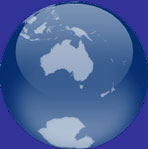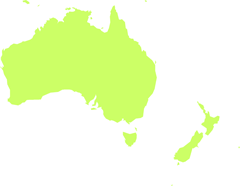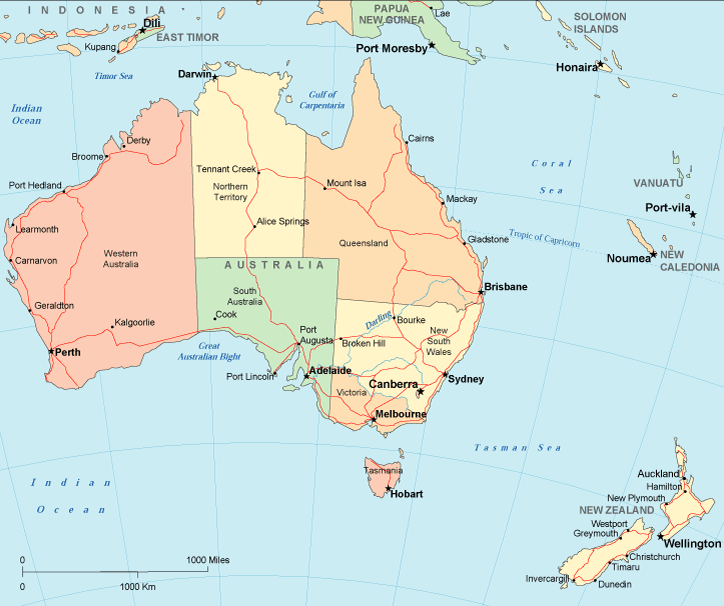
Map of Australia
Map of Australia > Australia History | Australia Travel Tips |
Australia Relief Map | Australia Topo Map
 The continent of Australia, including the islands of Oceania, encompasses
3,287,609 square miles. Its highest point is Mt. Wilhelm
in Papua New Guinea at 14,793 feet above sea level. Its lowest point
is Lake Eyre in Australia, at 50 feet below sea level.
Australia's and Oceania's combined approximate population in 2002 was
31,862,000. Australia and Oceania, sometimes called Australasia,
consists of Australia, New Zealand, Papua New Guinea, and many small
islands stretching northward and eastward into the Pacific Ocean.
It is bounded on the west by the Indian Ocean, on the east by the
Pacific Ocean, on the northwest by Asia, and on the south by the
Antarctic region. The longest river in Australia is the Murray
and Darling River which is about 2,310 miles long. Australia's largest lake is Lake Eyre (3,470 square miles).
The continent of Australia, including the islands of Oceania, encompasses
3,287,609 square miles. Its highest point is Mt. Wilhelm
in Papua New Guinea at 14,793 feet above sea level. Its lowest point
is Lake Eyre in Australia, at 50 feet below sea level.
Australia's and Oceania's combined approximate population in 2002 was
31,862,000. Australia and Oceania, sometimes called Australasia,
consists of Australia, New Zealand, Papua New Guinea, and many small
islands stretching northward and eastward into the Pacific Ocean.
It is bounded on the west by the Indian Ocean, on the east by the
Pacific Ocean, on the northwest by Asia, and on the south by the
Antarctic region. The longest river in Australia is the Murray
and Darling River which is about 2,310 miles long. Australia's largest lake is Lake Eyre (3,470 square miles).
 |
Australian Travel and Tourism > Australia Travel Destinations
Much of Australia is flat and very dry; the fertile coastal plain along the east coast is separated from the interior by the Great Dividing Range. The Pacific islands of Oceania mostly consist of coral reefs or have volcanic origins. Micronesia generally consists of the northern islands which lie between Palau and the Gilbert Islands, Melanesia stretches from Papua New Guinea to Fiji, and Polynesia includes the islands in the eastern and central South Pacific Ocean. The Tourism Australia site features extensive travel information about Australia.The largest city in Oceania is Sydney, Australia. Other leading cities include Melbourne, Australia and Auckland, New Zealand. Travelers to Australia, New Zealand, and the South Pacific often fly to the region via Qantas or Air New Zealand. The Sydney Morning Herald is a good source of news about Australasia.
Australia History and Antique Australia Map
This Australia history page provides an overview of Australian history and culture from ancient times to modern times. This vintage map of Australia shows the continent of Australia as it appeared in a 19th century atlas.Related Continent Map Sites
- Map Of Africa - Africa maps and travel info.
- Map Of Antarctica - Antarctica maps and geography.
- Map Of Asia - Asia maps and travel info.
Copyright © 2005-2025 Map-Of-Australia.us.
All rights reserved. About us.
Certain maps hereon are © Map Resources.
All rights reserved. About us.
Certain maps hereon are © Map Resources.